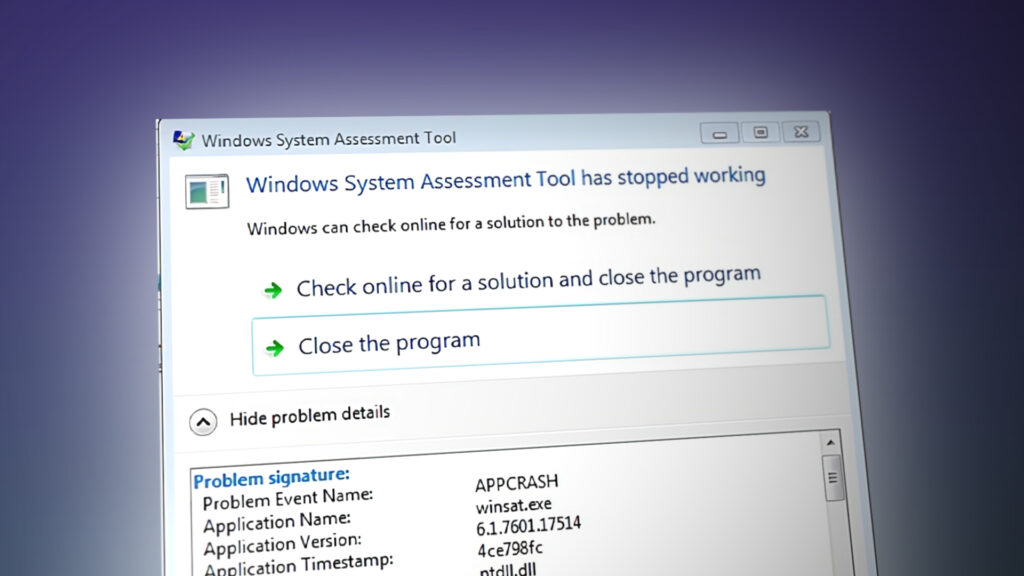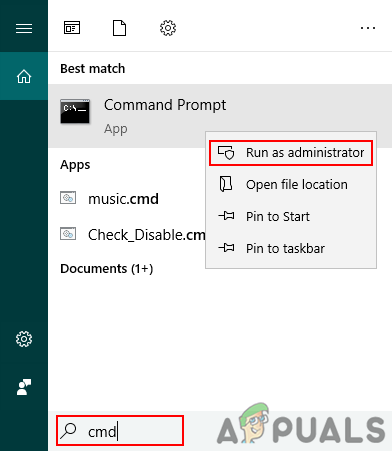Fix: Windows System Assessment Tool has stopped working
Windows system assessment tool is a testing tool that comes pre-installed on Windows. The tool is available on all Windows versions including Windows 10. Windows system assessment tool measures the performance parameters of your system’s hardware. While running the Windows system assessment tool, you might see an error Windows system assessment tool has stopped working. This error will prevent you from using this tool and the error can present itself at any stage of the testing. In some cases, you might see this error even if you weren’t running the Windows system assessment tool. In these types of cases, you might hear some random noises from the computer, especially from the GPU, and the system’s temperature might rise a lot.

The reason for this error isn’t quite clear. The Windows system assessment tool is depreciated since Windows 8.1. Although it is available in Windows 10 but without the GUI. The ratings provided by the Windows system assessment tool aren’t considered reliable by the majority of the people. So, there hasn’t been a lot of usages and, therefore, a lot of reports on its usage and problems. The most common things related to this error are video drivers and Windows updates. Installing new hardware and/or not having the latest video drivers have been linked to this issue. Conversely, some people have seen this error after updating a video driver. Skipping on Windows updates has also been linked to this issue and lots of people have resolved the issue by updating their Windows.
Since there are a couple of things that can cause the issue, there are a few things you can try out.
Tips
Tip 1: Sometimes, simply running the Windows System Assessment Tool from the command prompt solves the issue. Usually, the error is a onetime thing and isn’t a serious error.
- Press Windows key once
- Type cmd in the Start Search
- Right-click the Command Prompt from the search results and select run as administrator

Opening elevated command prompt - Type winsat formal and press Enter
It should run fine if the error shows up again then continue.
Tip 2: If rerunning the WinSAT from command prompt didn’t solve the issue and you are seeing unrated in the Windows Experience Indexing then do the following
- Hold Windows key and press R
- Type control panel and press Enter

Accessing the Classic Control Panel interface - Select Performance Information and Tools
- Select Advanced Tools
- Select Clear all Windows Experience Index scores and rerate the system option
Now, try to run the WinSAT again and see if it runs successfully.
Method 1: Update Video Drivers
If you are seeing this error after the installation of a new GPU then the problem will most likely resolve after the update of video drivers. In fact, try to check and update all of your drivers just to be on the safe side.
Here are the steps for updating the video drivers
- If you have installed a new graphics card like NVidia then go to their official website
- Search for the drivers on their website and download the one for your specific graphics card. You might have to select the operating system and the bit version as well. If you don’t know whether you have the 64-bit version or the 32-bit version then do the following
- Hold Windows key and press R
- Type dxdiag and press Enter
- Look at the operating system entry. You will see the Windows name and the bit version.


- Once downloaded, run the installer and it should update the graphics driver for you.
Reboot the system and check if the problem is resolved.
Note: Most of these graphic card companies have a driver management program as well. For NVidia, it’s NVidia GeForce. If you have one of these programs then simply open that and check for driver updates. If the program finds a newer version then install that.
Method 2: Uninstall and Reinstall the Video Drivers
For some people, the problem might start after updating the video drivers. There are cases when a newer driver version can create these kinds of problems. In these cases, you have to completely uninstall the previous version and then install the newer driver version. Simply installing a newer version on top of the older version doesn’t solve the issue.
Here are the steps for uninstalling and reinstalling the video drivers
- Hold Windows key and press R
- Type appwiz.cpl and press Enter

- Locate the driver from this list. Your GPU driver will be listed in this list.
- Select the driver and click Uninstall. Note: If you can’t find the drivers then uninstall the driver management utility e.g. NVidia GeForce.
- Once you are done, reboot the computer
- Now, go to the official website of your GPU manufacturer and download the latest driver. Install the driver and reboot to see if the problem is resolved. If you aren’t sure about how to download the drivers the follow the steps given in method 1.
Once the reinstall is done, you should be good to go.
Method 3: Install Windows Updates
Check whether you have installed all the Windows updates or not. A lot of users have solved the issue after installing all the Windows Updates.
Windows 10
- Press Windows key once
- Select Settings from the start menu

- Click Update & Security

- Click Check for updates

- Install the updates if the system finds any
Windows 7, 8 and 8.1
- Hold Windows key and press R
- Type control panel and press Enter

- Select small icons from the drop-down menu in View By (top right)

- Click Windows update

- Click Check for updates

- Install the updates if the system finds any
Once the updates are installed, reboot and check if the problem is resolved.
Method 4: Disable the WinSAT Scheduling
If you aren’t worried about why the error is happening but you simply want to get rid of the reoccurring error dialogue then this solution will work for you. It isn’t really a solution but more of a workaround. The Windows System Assessment Tool is a scheduled task on Windows. Almost all Windows versions (even Windows 10) will have this task as scheduled in the task scheduler. If you are seeing the error dialogue over and over again even if you didn’t run it in the first place then it might be because it tries to run after a certain period of time. So, disabling the scheduled task will prevent the tool from running.
Here are the steps for disabling the task scheduling of the Windows System Assessment Tool
- Hold Windows key and press R
- Type taskschd.msc and press Enter

- Double click Task Scheduler Library from the left pane
- Double click Microsoft folder from the left pane
- Double click Windows folder from the left pane
- Select the Maintenance folder from the left pane

- You will see a task named WinSAT in the right pane.
- Right-click the WinSAT task from the right pane and select Disable

That’s it. Close the task scheduler and you should be good to go.
Method 5: System Restore
This should be your last resort. If nothing else worked and the problem started appearing out of nowhere or after installing a certain software/driver then this option might work. A System Restore brings your computer back to a certain time. All the progress and programs installed after that time will be lost. So, if the problem was happening because of an update or a new driver then the issue should be resolved.
Method 6: Performing an SFC scan
In some cases, certain drivers or system files might be missing due to which this error is being triggered, therefore, it is recommended that first, you boot into a clean boot state and then run an SFC scan to check and fix any issues with system files. After completing these steps, check to see if the issue persists.
Once you have performed a system restore, the problem should be resolved.